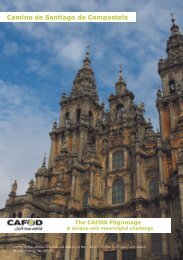Religious Education Curriculum Directory (3-19) - The Catholic ...
Religious Education Curriculum Directory (3-19) - The Catholic ...
Religious Education Curriculum Directory (3-19) - The Catholic ...
- No tags were found...
Create successful ePaper yourself
Turn your PDF publications into a flip-book with our unique Google optimized e-Paper software.
<strong>Catholic</strong> Bishops’ Conference of England and Wales — Department of <strong>Catholic</strong> <strong>Education</strong> and Formation(1177, 2708)D Scripture as basis for individual prayer and forprayer within small Christian communities andother parish, school, or local gatherings (2653-2654)1.2.4. Understanding scripture (105-1<strong>19</strong>)A Authentic interpretation of the Bible is the responsibilityof the teaching office of the Church (85-87,100)a Divino Afflante Spiritu (Pius XII, <strong>19</strong>43; per-mitted limited use of modern methods of biblicalcriticism)b Dei Verbum (DV) (Vatican II, <strong>19</strong>65; Churchteaching on Revelation)c Pontifical Biblical Commission, Interpretationof the Bible in the Church, <strong>19</strong>93, 5-<strong>19</strong>d Verbum Domini: a post-synodal apostolic ex-hortation issued by Pope Benedict XVI whichdeals with how the <strong>Catholic</strong> church should approachthe BibleB Criteria for interpreting the Sacred Scripture (109-114, 137)a Read and interpret Sacred Scripture withinthe tradition and teaching of the Churchb Give attention both to what the human au-thors intended to say and to what God revealsto us by their wordsc Take into account the conditions of the timewhen it was written and the culture in whichit was writtend Read and interpret Sacred Scripture in thelight of the same Holy Spirit by whom it waswritten (DV, 12-13)e Read and interpret each part of Sacred Scrip-ture with an awareness and understanding ofthe unity of the content and teaching of theentire Biblef Be attentive to the analogy of faith, that is, theunity that exists in all Church teachingC Senses of Scripture (115, 118-1<strong>19</strong>)a <strong>The</strong> literal sense: the meaning conveyed by thewords of Scripture and discovered by exegesis(109-110, 116)b <strong>The</strong> spiritual sense (117)i Allegorical sense: recognizing the signifi-cance of events in the Bible as they relate toChristii Moral sense: Scripture teaches us and en-courages us how to live and actc Anagogical sense: Scripture speaks to us ofeternal realitiesD <strong>The</strong> Bible in relation to science and history (37,159, <strong>19</strong>60)a <strong>The</strong> Church teaches us how to relate truths offaith to scienceb <strong>The</strong>re can be no conflict between religioustruth and scientific and historical truth (159)c <strong>The</strong> difference between the <strong>Catholic</strong> under-standing of Scripture and that of those whointerpret the Bible in an overly literalist, fundamentalistway or with an approach limitedto a symbolic or naturalistic understandingE Ancillary approaches to Scripturea Research done by scholars’ critiques of Scrip-ture’s texts, history, editing, etcb Biblical archaeology: discoveries of Dead SeaScrolls, Nag Hammadi, targums, and other authenticancient textsc <strong>The</strong> forms of literature in the Bible1.2.5. <strong>The</strong> Shape of the Bible (120-130)A Old Testament (121-123, 138)a This is the name given to the forty-six bookswhich make up the first part of the Bible andrecord salvation history prior to the coming ofthe Saviour, Jesus Christ (120)i Many Protestant Bibles have only thirty-ninebooks in the Old Testament; other ProtestantBibles contain the additional seven, referringto them as ‘deuterocanonical’ii <strong>Catholic</strong>s rely on the Greek version of the OldTestament for their Bible, while Protestantstend to rely on a Hebrew versionb It is called the ‘Old’ Testament because it re-lates God’s teaching and actions prior to thecoming of Jesus Christ, who is the fullness ofRevelation. It also focuses on the covenant Godmade with the Jewish people, which is calledthe ‘Old Covenant’ to distinguish it from theNew Covenant made by Jesus Christ (121-123)c <strong>The</strong> Old Testament contains the Pentateuch,the Historical books, the Wisdom books, andthe Prophetic booksB New Testament (120, 124-127)a This is the name given to those twenty-sevenbooks which compose the second part of theBible and which focus on the life and teachingsof Jesus Christ and some writings of theearly Church15
















